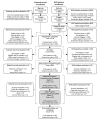Combining Artificial Intelligence and Human Support in Mental Health: Digital Intervention With Comparable Effectiveness to Human-Delivered Care
- PMID: 40152000
- PMCID: PMC12117275
- DOI: 10.2196/69351
Combining Artificial Intelligence and Human Support in Mental Health: Digital Intervention With Comparable Effectiveness to Human-Delivered Care
Abstract
Background: Escalating mental health demand exceeds existing clinical capacity, necessitating scalable digital solutions. However, engagement remains challenging. Conversational agents can enhance engagement by making digital programs more interactive and personalized, but they have not been widely adopted. This study evaluated a digital program for anxiety in comparison to external comparators. The program used an artificial intelligence (AI)-driven conversational agent to deliver clinician-written content via machine learning, with clinician oversight and user support.
Objective: This study aims to evaluate the engagement, effectiveness, and safety of this structured, evidence-based digital program with human support for mild, moderate, and severe generalized anxiety. Statistical analyses sought to determine whether the program reduced anxiety more than a propensity-matched waiting control and was statistically noninferior to real-world, propensity-matched face-to-face and typed cognitive behavioral therapy (CBT).
Methods: Prospective participants (N=299) were recruited from the National Health Service (NHS) or social media in the United Kingdom and given access to the digital program for up to 9 weeks (study conducted from October 2023 to May 2024). End points were collected before, during, and after the digital program, as well as at a 1-month follow-up. External comparator groups were created through propensity matching of the digital program sample with NHS Talking Therapies (NHS TT) data from ieso Digital Health (typed CBT) and Dorset HealthCare (DHC) University NHS Foundation Trust (face-to-face CBT). Superiority and noninferiority analyses were conducted to compare anxiety symptom reduction (change on the 7-item Generalized Anxiety Disorder Scale [GAD-7]) between the digital program group and the external comparator groups. The program included human support, and clinician time spent per participant was calculated.
Results: Participants used the program for a median of 6 hours over 53 days, with 232 of the 299 (77.6%) engaged (ie, completing a median of 2 hours over 14 days). There was a large, clinically meaningful reduction in anxiety symptoms for the digital program group (per-protocol [PP; n=169]: mean GAD-7 change -7.4, d=1.6; intention-to-treat [ITT; n= 99]: mean GAD-7 change -5.4, d=1.1). The PP effect was statistically superior to the waiting control (d=1.3) and noninferior to the face-to-face CBT group (P<.001) and the typed CBT group (P<.001). Similarly, for the ITT sample, the digital program showed superiority to waiting control (d=0.8) and noninferiority to face-to-face CBT (P=.002), with noninferiority to typed CBT approaching significance (P=.06). Effects were sustained at the 1-month follow-up. Clinicians overseeing the digital program spent a mean of 1.6 hours (range 31-200 minutes) of clinician time in sessions per participant.
Conclusions: By combining AI and human support, the digital program achieved clinical outcomes comparable to human-delivered care, while significantly reducing the required clinician time by up to 8 times compared with global care estimates. These findings highlight the potential of technology to scale evidence-based mental health care, address unmet needs, and ultimately impact quality of life and reduce the economic burden globally.
Trial registration: ISRCTN Registry ISRCTN52546704; http://www.isrctn.com/ISRCTN52546704.
Keywords: AI; anxiety; digital intervention; external control; human-in-loop; mental health; smartphone; synthetic control.
©Clare E Palmer, Emily Marshall, Edward Millgate, Graham Warren, Michael Ewbank, Elisa Cooper, Samantha Lawes, Alastair Smith, Chris Hutchins-Joss, Jessica Young, Malika Bouazzaoui, Morad Margoum, Sandra Healey, Louise Marshall, Shaun Mehew, Ronan Cummins, Valentin Tablan, Ana Catarino, Andrew E Welchman, Andrew D Blackwell. Originally published in the Journal of Medical Internet Research (https://www.jmir.org), 13.05.2025.
Conflict of interest statement
Conflicts of Interest: The chief investigator (E Marshall) and other investigators (CEP, E Millgate, GW, ME, EC, SL, AS, CHJ, JY, MB, LM, SM, RC, VT, AC, AEW, and ADB) are employees of ieso Digital Health Limited (the company funding this research) or its subsidiaries. None of these authors had any direct financial incentive related to the results of this study or the publication of this manuscript.
Figures






References
-
- World Health Organization (WHO) Mental Health | Key facts. WHO. 2022. [2024-06-24]. https://tinyurl.com/3by7wbu5 .
-
- Alonso Jordi, Liu Zhaorui, Evans-Lacko Sara, Sadikova Ekaterina, Sampson Nancy, Chatterji Somnath, Abdulmalik Jibril, Aguilar-Gaxiola Sergio, Al-Hamzawi Ali, Andrade Laura H, Bruffaerts Ronny, Cardoso Graça, Cia Alfredo, Florescu Silvia, de Girolamo Giovanni, Gureje Oye, Haro Josep M, He Yanling, de Jonge Peter, Karam Elie G, Kawakami Norito, Kovess-Masfety Viviane, Lee Sing, Levinson Daphna, Medina-Mora Maria Elena, Navarro-Mateu Fernando, Pennell Beth-Ellen, Piazza Marina, Posada-Villa José, Ten Have Margreet, Zarkov Zahari, Kessler Ronald C, Thornicroft Graham, WHO World Mental Health Survey Collaborators Treatment gap for anxiety disorders is global: results of the World Mental Health Surveys in 21 countries. Depress Anxiety. 2018 Mar;35(3):195–208. doi: 10.1002/da.22711. http://hdl.handle.net/2027.42/142890 - DOI - PMC - PubMed
-
- Data page: psychiatrists per 100,000 people. Our World in Data. 2023. [2024-07-03]. https://ourworldindata.org/grapher/psychiatrists-working-in-the-mental-h... .
-
- Health Professional Shortage Areas. 2024. Feb 7, [2004-07-03]. https://data.hrsa.gov/topics/health-workforce/shortage-areas .
-
- Roland J, Lawrance E, Insel T, Christensen H. The Digital Mental Health Revolution: Transforming Care Through Innovation and Scale-Up. Doha, Qatar: World Innovation Summit for Health; 2020.
MeSH terms
LinkOut - more resources
Full Text Sources
Medical
Miscellaneous

